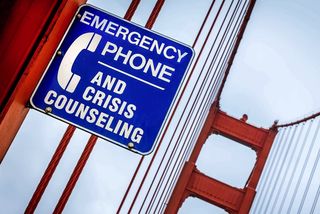Teen Suicide Clusters Linked to Newspaper Reports

For years, public health officials and mental health experts have warned journalists against reporting on suicides in great detail, and romanticizing the stories of people who took their own lives, out of fear that such stories could trigger vulnerable readers to commit suicide themselves.
Now, one of the most comprehensive studies yet shows how influential news reports can be. In analyzing 48 cases of suicide clusters, researchers found that groups of suicides are more likely to be preceded by news reports on suicide than individual suicides.
"Our findings indicate that the more sensational the coverage of the suicides, and the more details the story provides, then the more likely there are to be more suicides," study researcher Dr. Madelyn Gould of the New York State Psychiatric Institute said in a statement.
The link between news and future suicides was strongest when the media reported on the suicide of a famous person, or when news reports included details such as the time, place and method of suicide, the researchers report today (May 1) in the journal The Lancet Psychiatry.
Preventing suicide clusters
Suicide is the 14th-leading cause of all deaths worldwide, responsible for 1.5 percent of all mortality, according to a review also published today in the same journal. More than 90 percent of people who die by suicide have a diagnosable mental disorder, though not all are diagnosed or treated. [5 Myths About Suicide, Debunked]
If you or someone you know is suicidal, the National Suicide Prevention Lifeline can be reached 24 hours a day at 800-273-TALK (8255). Some signs of suicidal behavior include talking about wanting to die, feeling trapped or hopeless and changes in sleep patterns.
Sign up for the Live Science daily newsletter now
Get the world’s most fascinating discoveries delivered straight to your inbox.
While many suicide attempts are singular events, some come in clusters. After a prominent suicide in the community, suicide rates in that area might temporarily spike. In the case of a celebrity suicide, the suicide rate could go up nationwide.
To combat suicide clusters, organizations such as the American Foundation for Suicide Prevention (AFSP) recommends avoiding sensationalized headlines or excessive detail about the death, and including information on warning signs and where to get help. [Suicide: Red Flags to Watch For]
News and suicide
In the new study, Gould and her colleagues looked at mortality information from the 48 contiguous U.S. states between 1988 and 1996, before Internet news became widespread. The researchers focused on teen suicide clusters, or three-month periods in a town or city where the suicide rate for 13- to 20-year-olds suddenly peaked.
They found 53 clusters, but excluded several from the study because they involved suicide pacts or for other technicalities, leaving 48 clusters of from three to 11 suicides each, in the final analysis.
The researchers then examined newspaper archives from the period between the first suicide in each cluster and the second. Each cluster was compared with a single suicide in the same community involving a teenager.
The results showed that clustered suicides were preceded, on average, by more news stories than noncluster suicides. Before clusters, there were up to 55 stories on the initial suicide, with a median (or middle number, a way to calculate the average when outliers might skew other methods) of four stories. Before noncluster suicides, there were up to 36 news stories, with a median of three.
The researchers then checked whether more heavily reported suicides had involved more dramatic stories, which might potentially both increase coverage and increase the likelihood of a cluster. They found no difference in location or suicide method between heavily covered suicides and ones that received little media attention.
Old and new media
The likelihood of a suicide cluster also increased if newspapers reported on a celebrity suicide, or if they included details such as the method of suicide, the time and place of death, and any unfavorable characteristics of the deceased.
"Although we cannot show causality, our findings support the interpretation that media portrayals of suicide might have a role in the emergence of some teenage suicide clusters," the researcher wrote.
It's not exactly clear why detailed reporting on suicide might increase the risk that others will kill themselves, they said. One possibility is that news stories of suicide brings up the idea in depressed people's minds, making it more likely that they look to suicide as a solution to their problems. Another possibility is that news reports on suicide normalize suicidal behavior.
Today's social media environment might be another place that vulnerable teens come across news of suicide. The theory was advanced in an editorial published alongside the study by University of Melbourne researchers Jane Pirkis and Jo Robinson, who were not involved in it. Social media is unregulated and might be more dangerous than the traditional news media because it can be more sensational and interactive, Pirkis and Robinson warned.
"Investigating the role of newer media in suicide clusters … is the next logical step," they wrote.
Follow Stephanie Pappas on Twitter and Google+. Follow us @livescience, Facebook & Google+. Original article on Live Science.

Stephanie Pappas is a contributing writer for Live Science, covering topics ranging from geoscience to archaeology to the human brain and behavior. She was previously a senior writer for Live Science but is now a freelancer based in Denver, Colorado, and regularly contributes to Scientific American and The Monitor, the monthly magazine of the American Psychological Association. Stephanie received a bachelor's degree in psychology from the University of South Carolina and a graduate certificate in science communication from the University of California, Santa Cruz.